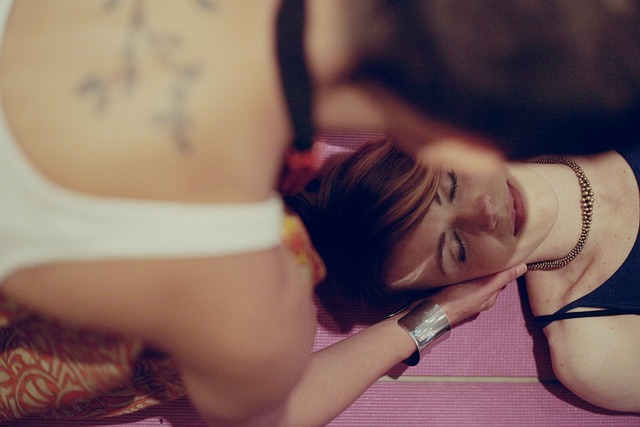Alignment therapy, rooted in yoga principles, is a holistic approach to improving body mechanics. Through specific poses, stretching, and mindfulness practices like Downward-Facing Dog and Warrior II, individuals can enhance balance, flexibility, and joint health. Combining dynamic stretches with targeted static holds allows for personalized progress, addressing areas of tension or imbalance. Yoga's ancient techniques, incorporating breathwork and mind-body connection, offer a powerful tool for stress reduction, muscle release, and long-term postural improvements.
Enhance your body alignment and overall well-being with yoga and stretching routines. In today’s world, many of us spend long hours sitting or standing improperly, leading to misalignment and discomfort. Alignment therapy, a core concept in yoga, offers a holistic approach to counteract these issues. This article guides you through understanding alignment therapy, exploring key poses for better posture and balance, creating personalized stretching routines, and discovering the broader benefits of yoga beyond physical alignment.
- Understanding Alignment Therapy: The Foundation of Yoga
- Key Poses for Enhancing Posture and Balance
- Creating a Personalized Stretching Routine
- Benefits Beyond Alignment: Yoga's Holistic Approach to Well-being
Understanding Alignment Therapy: The Foundation of Yoga

Alignment therapy, a core principle in yoga practice, focuses on improving posture and overall physical alignment through specific poses and stretching routines. It’s about much more than just looking good—proper alignment promotes better balance, enhances flexibility, and reduces tension and strain on joints and muscles. By understanding the body’s natural alignment, practitioners can target areas that need extra care and cultivate a stronger, more balanced physique.
Yoga serves as an excellent foundation for alignment therapy due to its emphasis on mindfulness, breath control, and precise body positioning. Various yoga poses are designed to stretch, strengthen, and rebalance the body, ensuring each component works in harmony. Regular practice can help correct postural imbalances, alleviate chronic pain, and improve overall well-being.
Key Poses for Enhancing Posture and Balance

Yoga and stretching routines are powerful tools for enhancing body alignment, which in turn improves posture and balance. Key poses such as the Downward-Facing Dog (Adho Mukha Svanasana) lengthen and strengthen the spine, hamstrings, and calves, promoting a neutral spinal alignment. The Warrior II (Virabhadrasana II) pose helps to open up the hips and stabilize the shoulders, leading to better balance and postural awareness.
Additionally, the Child’s Pose (Balasana) is excellent for releasing tension in the back and shoulders, allowing the spine to return to its natural curve. The Plank (Kumbhakasana) position challenges your core muscles, helping to build strength and stability that supports a strong and aligned posture throughout the day. These poses, when practiced regularly as part of an alignment therapy routine, can significantly improve overall body alignment, posture, and balance.
Creating a Personalized Stretching Routine

Creating a personalized stretching routine is a powerful step towards achieving optimal body alignment through alignment therapy. Start by identifying areas that need extra care—whether it’s tight hamstrings, a rounded spine, or stiff shoulders. Incorporate dynamic stretches before your yoga practice to warm up muscles and increase flexibility, focusing on major joints and muscle groups. For targeted relief, add static holds during your yoga session, holding each stretch for 30 seconds to several minutes.
Customize your routine by combining different types of stretches—forward bends, twists, hip opens, and chest expands—to create a flow that resonates with your body. Regularly assess your progress and adjust your practice as needed, ensuring you challenge yourself while remaining mindful of any discomfort. Remember, consistency is key to seeing improvements in body alignment over time.
Benefits Beyond Alignment: Yoga's Holistic Approach to Well-being

Yoga goes beyond mere body alignment, offering a holistic approach to well-being that has been practiced for centuries. The practice’s emphasis on breathwork and mindfulness cultivates a deeper connection between mind and body, promoting relaxation and stress relief. This mental component is crucial in aligning not just the physical form but also the emotional state.
Alignment therapy through yoga helps release tension stored in muscles, improving posture and reducing pain. However, its benefits extend to enhancing flexibility, balance, and strength—all contributing to a more harmonious and functional body. By integrating mindfulness and breath control, yoga encourages individuals to become aware of their bodies’ needs, fostering a sense of self-care and overall health improvement.
Yoga and stretching routines, grounded in alignment therapy, offer a holistic approach to enhancing body alignment, posture, and balance. By incorporating key poses and personalizing your practice, you can achieve better physical well-being and overall quality of life. Remember that consistency is key; regular sessions will yield significant benefits over time. So, dive into these practices to unlock your body’s potential for strength, flexibility, and harmony.
